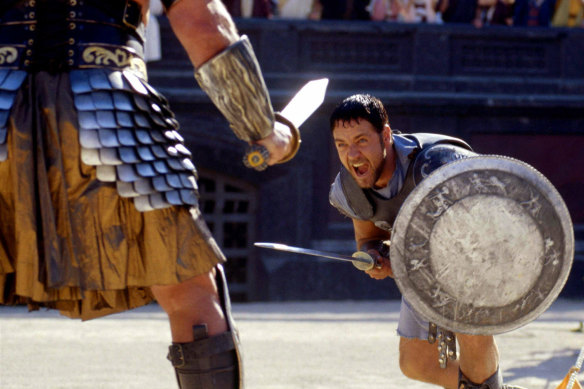This was published 1 year ago
How often do men think about ancient Rome? Quite frequently, it seems
By Leo Sands
It’s been almost 2000 years since the Roman Empire reached the historic peak of its power. But many men still contemplate it - quite a lot.
A new social media trend prompting women to ask the men in their lives how often they think about ancient Rome reveals that it crosses the minds of many men on a weekly basis. Even daily. Or more - to the surprise and confusion of their loved ones.

Thinking about ancient Rome? You’re not alone. A scene from The Gladiator, staring Russell Crowe.Credit: AP
“Three times a day,” answered one woman’s fiancé in a TikTok video. “There’s so much to think about,” he explained, eliciting a stunned look into the camera from his soon-to-be wife.
“They built an entire world-dominating society,” another man exclaimed when asked by a bewildered-looking woman to justify why he contemplates ancient Rome.
“Actually I was just having a conversation about their aqueducts and the fact that they had concrete that could harden. . . . How the hell did you know that?” answered another person who said they think about ancient Rome “at least once a day” in response to the question, in a screenshot shared on TikTok.
But why? Sure, the Roman Empire boasted a dominion that stretched across the entire Mediterranean basin and far beyond. It was a flourishing laboratory of works of art and engineering that continue to astound. And it operated under a political system that still forms the basis of many modern counterparts. (At least, that’s what this reporter contemplates, maybe once a fortnight.)
But why does there seem to be a gender divide in who is daydreaming about ancient Rome today?
According to historians, one explanation could be that Western societies have historically overemphasized the aspects of Roman history that are associated with masculinity in the popular imagination.
The first thing that comes to the mind is “an image of the Roman legion, the imperial eagle and that sort of military aspect - along with gladiators, which has a long association with masculinity and power,” Hannah Cornwell, a historian of the ancient world at Britain’s Birmingham University, said in a telephone interview on Thursday.
Since at least the 19th century, she said, historians have tended to view ancient Rome through the prism of politics and warfare, in part as a result of their reliance on “elite, masculine” sources.
“That has informed popular culture,” she said. “And yet - it’s then missing out on so much.”
The slew of videos on TikTok appear to have been prompted by Artur Hulu, a 32-year-old Roman reenactor and history influencer from Sweden who has earned a large following.
Known as “Gaius Flavius” online, where he posts videos of himself as a Roman legionnaire and performs comedy sketches as a gladiator, Hulu wrote on Instagram: “Ladies, many of you do not realise how often men think about the Roman Empire. . . . You will be surprised by their answers!”
In an interview, Hulu said he posed the question after noticing a disparity between men and women in their interest in Roman history and seeing other creators discuss similar trends. Hulu’s Roman reenactment society, for example, involves 16 men and two women, he said. “It is heavily male dominated.”
The disparity in interest dates back hundreds of years, Hulu believes. “The men during the Renaissance did it. The Founding Fathers also thought about the Roman Empire. Once you get enough exposure to the Roman Empire, whether it’s the military stuff or the law, you start to see it everywhere,” he said. “I can’t remember a day when I didn’t think about the Roman Empire. . . . It just fascinates me how different but also how similar the Roman Empire is to our world today.”
And “Gaius Flavius” is not alone. One Reddit user, when prompted by his wife, said he thinks about the Roman Empire a few times a week.
“So many things in our lives today were influenced by the Roman Empire,” he explained in a post. “Language, food, philosophy, architecture, war, entertainment, sports, mythology, culture. . . . I don’t actively focus on the Roman Empire but the connection always pops into my head as I go about my daily life.”

Aqueducts are one of the things the Romans did for us.Credit: Alamy
Historians insist that Rome itself isn’t just “guy stuff,” as some men in videos called it.
“Ancient Rome was of course patriarchal and violent,” Lewis Webb, a historian of ancient Rome at Oxford University, wrote in an email. “But it was also a diverse place: there were numerous forms of masculinity, women could have agency and power, and there were multiple gender expressions and identities, as well as various sexualities.”
Historian Cornwell also points out that Sextus Varius Avitus Bassianus, or Elagabalus, the Roman emperor from AD 218 to 222, is frequently presented in ancient sources as experimenting with cross-dressing.
“Even when you get to some of the emperors, they’re doing weird and wacky things by modern conceptions of what a man is,” Cornwell points out. There were also female gladiators. “The Romans do have a clear sense of what is masculine and feminine, but within that there is an awful lot of flexibility. Which sometimes we often forget about,” she said.

Rome’s ancient Colosseum.Credit: iStock
And she herself, of course, thinks about the Roman Empire quite a lot - on a daily basis, as it is her chosen field. Her partner recently told her he thinks about it “1.6 times a month.”
So what is a healthy amount?
“Goodness,” she said, laughing. “I’d say it really depends on what you’re thinking about.”
Washington Post
Get a note directly from our foreign correspondents on what’s making headlines around the world. Sign up for the weekly What in the World newsletter here.